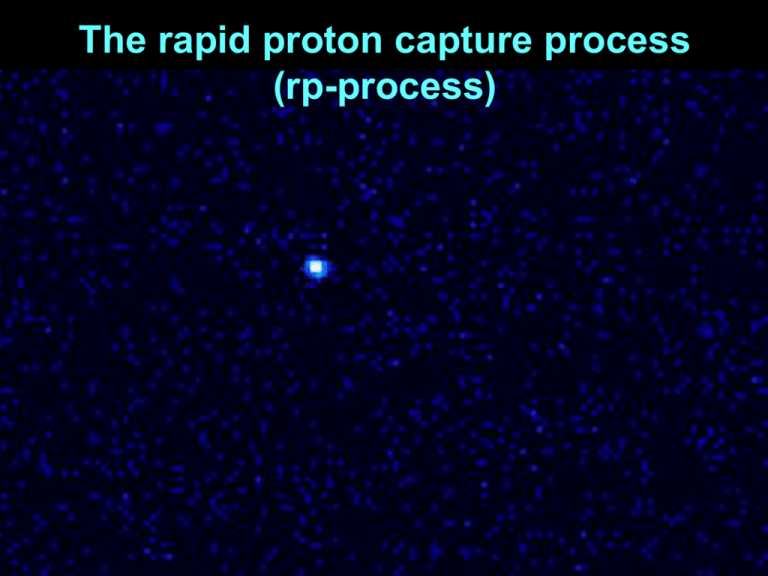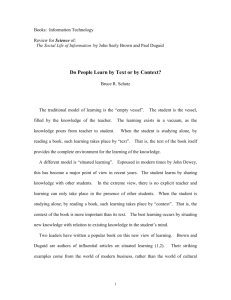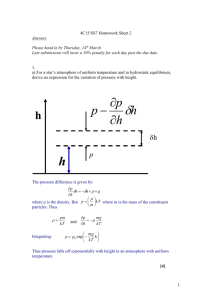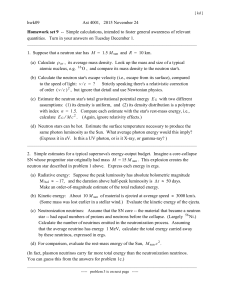Notes
advertisement

The rapid proton capture process (rp-process) Sites of the rp-process This lecture Novae n-wind in supernovae ? X-ray binaries Nova Cygni 1992 with HST E0102-73.3 composite • “r”p-process (not really a full rp-process) • makes maybe 26Al •makes maybe 45Sc and 49Ti • if n accelerated (n interactions) maybe a major nucleosynthesis process? KS 1731-260 with Chandra • full rp-process • unlikely to contribute to nucleosynthesis X-rays in the sky D.A. Smith, M. Muno, A.M. Levine, R. Remillard, H. Bradt 2002 (RXTE All Sky Monitor) Cosmic X-rays: discovered end of 1960’s: 0.5-5 keV (T=E/k=6-60 x 106 K) Nobel Price in Physics 2002 for Riccardo Giacconi Discovery Discovery of X-ray bursts and pulsars H. Schatz First X-ray pulsar: Cen X-3 (Giacconi et al. 1971) with UHURU T~ 5s Today: ~50 First X-ray burst: 3U 1820-30 (Grindlay et al. 1976) with ANS 10 s Today: ~70 burst sources out of 160 LMXB’s Total ~230 X-ray binaries known H. Schatz Burst characteristics Typical X-ray bursts: • 1036-1038 erg/s • duration 10 s – 100s • recurrence: hours-days • regular or irregular Frequent and very bright phenomenon ! (stars 1033-1035 erg/s) Accreting neutron stars Accreting neutron stars The Model H. Schatz The model Neutron stars: 1.4 Mo, 10 km radius (average density: ~ 1014 g/cm3) Donor Star (“normal” star) Neutron Star Accretion Disk Typical systems: • accretion rate 10-8/10-10 Mo/yr (0.5-50 kg/s/cm2) • orbital periods 0.01-100 days • orbital separations 0.001-1 AU’s NASA H. Schatz Energy sources Energy generation: thermonuclear energy 4H 4He 6.7 MeV/u 3 4He 12C 0.6 MeV/u (“triple alpha”) 5 4He + 84 H 104Pd 6.9 MeV/u (rp process) Energy generation: gravitational energy E= G M mu R = 200 MeV/u Ratio gravitation/thermonuclear ~ 30 – 40 (called a) H. Schatz Observation of thermonuclear energy Unstable, explosive burning in bursts (release over short time) Burst energy thermonuclear Persistent flux gravitational energy H. Schatz Burst ignition Burst trigger rate is “triple alpha reaction” Ignition: 10 -1 2 -1 decool > dT enuc ecool ~ T4 12C Nuclear energy generation rate Cooling rate Triple alpha reaction rate -9 reaction rate (cm s mole ) denuc dT 3 4He -10 10 Ignition < 0.4 GK: unstable runaway (increase in T increases enuc that increases T …) -11 10 -12 10 -13 10 -14 10 degenerate e-gas helps ! -15 10 0 1 temperature (GK) 10 BUT: energy release dominated by subsequent reactions ! H. Schatz At large (local) accretion rates 0.24 at high local accretion rates m > medd (medd generates luminosity Ledd) temperature (GK) 0.23 0.22 0.21 0.2 0.19 0.18 0.17 0.16 -2 10 -1 10 accretion rate (L_edd) Triple alpha reaction rate -9 2 -1 -1 reaction rate (cm s mole ) 10 -10 10 -11 10 Stable nuclear burning -12 10 -13 10 -14 10 -15 10 0 1 temperature (GK) 10 0 10 H. Schatz X-ray pulsar > 1012 Gauss ! High local accretion rates due to magnetic funneling of material on small surface area http://www.gsfc.nasa.gov/topstory/2003/0702pulsarspeed.html Golden Age for X-ray Astronomy ? XMM Newton Constellation X RXTE XMM Chandra RXTE H. Schatz Open question I: ms oscillations 4U1728-34 Rossi X-ray Timing Explorer Picture: T. Strohmeyer, GSFC Neutron Star spin frequency Now proof from 2 bursting pulsars (SAX J1808.4-3658, XTE J1814-338) (Chakrabarty et al. Nature 424 (2003) 42 Strohmayer et al. ApJ 596 (2003)67) • Origin of oscillations ? • Why frequency drift ? H. Schatz The bursting pulsar SAX J1808.4-3658 D. Chakrabarty et al. Nature 424 (2003) 42 Pulsar Frequency Seconds since burst Origin of frequency drift in normal bursting systems ??? (rotational decoupling ? Surface pulsation modes ?) H. Schatz Open question II: ignition and flame propagation Anatoly Spitkovsky (Berkeley) H. Schatz Open question III: burst behavior at large accretion rates Regular burst duration (s) Regular burst rate /day superbursts a:~40 superbursts a: 500-5000 Accretion rate (Edd units) Cornelisse et al. 2003 Accretion rate (Edd units) H. Schatz Open question IV: superbursts X 1000 duration ( can last ½ day) X 1000 energy Normal Burst 11 seen in 9 sources Recurrence ~1 yr ? 4U 1820-30 Often preceeded by regular burst H. Schatz Open question V: abundance observations ? EXO0748-676 Cottam, Paerels, Mendez 2002 H. Schatz New era of precision astrophysics Precision X-ray observations Uncertain models due to nuclear physics (NASA’s RXTE) Galloway et al. 2003 97-98 2000 Burst models with different nuclear physics assumptions GS 1826-24 burst shape changes ! Woosley et al. 2003 astro/ph 0307425 (Galloway 2003 astro/ph 0308122) But only with precision nuclear physics Fate of matter accreted onto a neutron star accretion rate: ~10 kg/s/cm2 Neutron star surface Neutron star surface Neutron star surface Neutron star surface Neutron star surface Accreted matter (ashes) Neutron star surface Accreted matter is incorporated deeper into the neutron star As the density increases interesting things happen H. Schatz Nuclear physics overview Accreting Neutron Star Surface n’s ~1 m X-ray’s H,He fuel Spallation of heavy nuclei ? Thermonuclear H+He burning (rp process) X-ray bursts gas ashes ~10 m ocean ~100 m outer crust ~1 km 10 km Inner crust core Deep burning ? superbursts Crust processes (EC, pycnonuclear fusion) crust heating crust conductivity Step 1: Thermonuclear burning in atmosphere Neutron star surface H,He gas ocean outer crust Inner crust ~ 4m, r=106 g/cm3 Woosley et al. 2003 Kippenhahn diagram depth time H. Schatz Conditions during an X-ray burst Ignition layer ocean Burst cooling Ignition surface J. Fisker Thesis (Basel, 2004) H. Schatz Visualizing reaction networks Proton number (a,g) (p,g) 14 27Si 13 (a,p) (,b+) neutron number dY j dYi Lines = Flow = Fi , j dt i j dt dt j i Al (13) Mg (12) Na (11) Ne (10) Burst Ignition: 15 16 13 14 F (9) O (8) N (7) C (6) B (5) Be (4) Li (3) He (2) 3 4 5 H (1) n (0) 2 0 1 11 12 9 10 8 7 6 Prior to ignition ~0.20 GK Ignition : hot CNO cycle : 3a : Hot CNO cycle II ~ 0.68 GK breakout 1: 15O(a,g) ~0.77 GK breakout 2: 18Ne(a,p) (~50 ms after breakout 1) Leads to rp process and main energy production H. Schatz How the rp-process works Nuclear lifetimes: (average time between a …) • A+pB+g proton capture : t = 1/(Yp r NA <sv>) • b+ decay : t = T1/2/ln2 • B+gA+p photodisintegration : t = 1/l(g,p) Z 43 (Tc) (for r=106 g/cm3, Yp=0.7, T=1.5 GK) 42 (Mo) 10 10 8 10 41 (Nb) 6 10 4 10 Lifetime (s) 40 (Zr) 39 (Y) 2 10 0 10 -2 10 -4 38 (Sr) 10 -6 10 N=41 -8 10 -10 10 Endpoint ? 38 39 40 41 neutron number Proton number 42 43 H. Schatz The endpoint of the rp-process Possibilities: • Cycling (reactions that go back to lighter nuclei) • Coulomb barrier • Runs out of fuel • Fast cooling Proton capture lifetime of nuclei near the drip line 4 Event timescale 10 2 10 lifetime (s) 0 10 -2 10 -4 10 -6 10 -8 10 -10 10 0 10 20 30 40 50 charge number Z 60 70 80 H. Schatz Waiting points Slow reactions extend energy generation abundance accumulation (steady flow approximation lY=const or Y ~ 1/l) Critical “wating points” can be easily identified in abundance movie Endpoint: Limiting factor I – SnSbTe Cycle The Sn-Sb-Te cycle Known ground state a emitter (g,a) 105Te 106Te 107Te 108Te 104Sb 105Sb 106 107Sb Sb Sb (51) Sn (50) In (49) Cd (48) Ag (47) Pd (46) Rh (45) Ru (44) (p,g) 103Sn 102In 104Sn 103In 105Sn 104In 106Sn Xe (54) I (53) Te (52) 59 5758 Tc (43) Mo (42) Nb (41) Zr (40) Y (39) Sr (38) b+ 56 5455 Rb (37) Kr (36) Br (35) Se (34) 105In 53 5152 4950 As (33) Ge (32) Ga (31) Zn (30) 45464748 424344 41 Cu (29) 37383940 Ni (28) Co (27) 33343536 Fe (26) Mn (25) 3132 Cr (24) V (23) 2930 Ti (22) Sc (21) 25262728 Ca (20) K (19) 2324 Ar (18) Cl (17) 2122 S (16) P (15) 17181920 Si (14) Al (13) 1516 Mg (12) Na (11) 14 Ne (10) F (9) 11 1213 O (8) N (7) 9 10 C (6) B (5) 7 8 Be (4) (Schatz et al. PRL 86(2001)3471) Li (3) He (2) 5 6 H (1) 3 4 0 1 2 Collaborators: L. Bildsten (UCSB) A. Cumming (UCSC) M. Ouellette (MSU) T. Rauscher (Basel) F.-K. Thielemann (Basel) M. Wiescher (Notre Dame)




